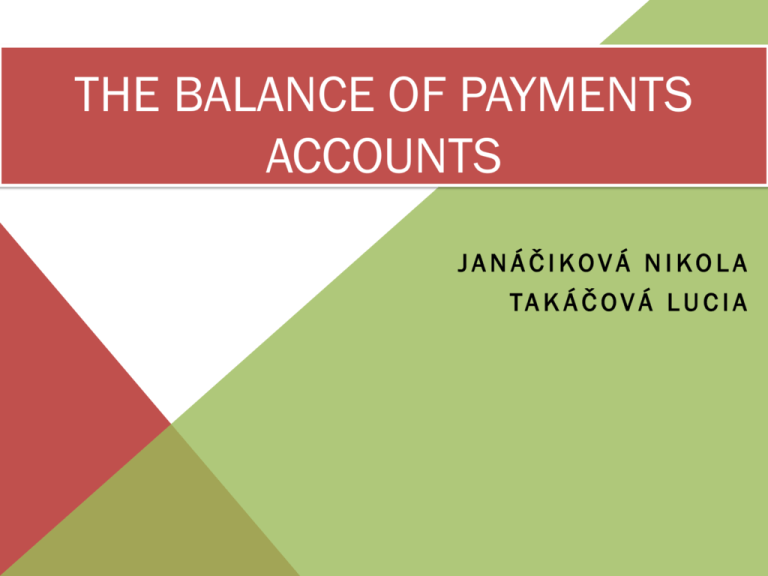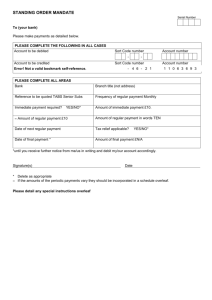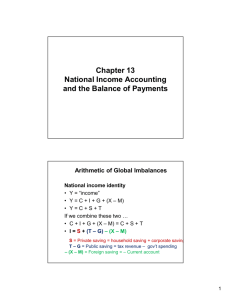
THE BALANCE OF PAYMENTS
ACCOUNTS
JANÁČ IKOVÁ NI KOLA
TA K Á Č O V Á L U C I A
BOP – WHAT IS IT?
The balance of payments (BOP) is the method countries
use to monitor all international monetary transactions
at a specific period of time. Usually, the BOP is
calculated every quarter and every calendar year.
All trades conducted by both the private and public
sectors are accounted for in the BOP in order to
determine how much money is going in and out of a
country.
Rule:
Sell something to rest of world, receive payment - enters as credit (+).
Buy something from rest of the world, make payment - enters as debit (-).
THREE TYPES OF INTERNATIONAL TRANSACTION ARE
RECORDED IN THE BALANCE OF PAYMENTS
The BOP is divided into three main categories:
1. The current account - exports or imports of goods or services
2. The capital account - transfers of wealth between countries
3. The financial account - purchases or sales of financial assets
Within these three categories are sub-divisions, each of
which accounts for a different type of international
monetary transaction.
Think:
All international transactions require foreign currency. All credit
transactions give rise to supply of foreign exchange. All debit
transactions give rise to demand for foreign exchange
1. THE CURRENT ACCOUNT
The current account is used to mark the inflow and
outflow of goods and services into a country.
Earnings on investments, both public and private,
are also put into the current account.
For example:When a French consumer imports American
blue jeans, for example, the transaction enters the U.S.
balance of payments accounts as a credit on the current
account.
• The balance of the current account
tells us if a country has a deficit or a
surplus.
2. THE CAPITAL ACCOUNT
The capital account is where all international capital transfers are
recorded. This refers to the acquisition or disposal of nonfinancial assets and non-produced assets, which are needed for
production but have not been produced, like a mine used for the
extraction of diamonds.
The capital account is broken down into the monetary flows
branching from debt forgiveness, the transfer of goods, and
financial assets by migrants leaving or entering a country, the
transfer of ownership on fixed assets, the transfer of funds
received to the sale or acquisition of fixed assets, gift and
inheritance taxes, death levies and, finally, uninsured damage to
fixed assets.
3. THE FINANCIAL ACCOUNT
In the financial account, international monetary flows
related to investment in business, real estate, bonds
and stocks are documented. Also included are
government-owned assets such as foreign reserves,
gold, special drawing rights held with the International
Monetary Fund (IMF), private assets held abroad and
direct foreign investment. Assets owned by foreigners,
private and official, are also recorded in the financial
account.
PAIRED TRANSACTIONS
• Every international transaction enters the
balance of payments twice, once as a credit
and once as a debit
• If you buy something from a foreigner, you
must pay her. She must then spend or store
your payment.
5 EXAMPLES OF PAIRED TRANSACTIONS
1. A U.S. citizen buys a $1000 typewriter from an Italian company, and the
Italian company deposits the $1000 in its account at Citibank in New York.
•
That is, the U.S. trades assets for goods.
This transaction creates the following two offsetting entries in the U.S. balance
of payments:
•
It enters the U.S. CA with a negative sign (-$1000 import).
•
It shows up as a $1000 credit in the U.S. financial account. ($1000 inflow to
CitiBank).
5 EXAMPLES OF PAIRED TRANSACTIONS
2.
A U.S. citizen pays $200 for dinner at a French restaurant in France by
charging his Visa credit card.
That is, the U.S. trades assets for services.
This transaction creates the following two offsetting entries in the U.S.
balance of payments:
DOPLŇTE
FILL
• It enters the U.S. CA with a negative sign (-$200 import).
• It shows up as a $200 credit in the U.S. financial account.(the French have lent us
$200)
5 EXAMPLES OF PAIRED TRANSACTIONS
3. A U.S. citizen buys a $95 newly issued share of stock in the United
Kingdom oil giant British Petroleum (BP) by using a check drawn on his
stockbroker money market account. BP deposits the $95 in its own U.S.
bank account at Second Bank of Chicago.
That is, the U.S. trades assets for assets.
This transaction creates the following two offsetting entries in
the U.S. balance of payments:
DOPLŇTE
FILL
• It enters the U.S. financial account with a negative sign ($95, a financial outflow).
• The check shows up as a $95 credit in the U.S. financial
account. ((+$95, a financial inflow to Citibank).
5 EXAMPLES OF PAIRED TRANSACTIONS
4. U.S. banks forgive $5,000 in debt owed to them by the government of the
imaginary country of Bygonia.
United States makes a $5,000 capital transfer to Bygonia, which appears as a
$5,000 debit entry in the capital account. The associated credit is in the
financial account, in the form of a $5,000 reduction in U.S. assets held
abroad (a negative “acquisition” of foreign assets, and therefore a balance
of payments credit):
•
U.S. banks’ debt forgiveness (Capital account, U.S. transfer payment), 5000
•
Reduction in banks’ claims on Bygonia (Financial account, U.S. asset
sale), +5000
5 EXAMPLES OF PAIRED TRANSACTIONS
5. Suppose we buy from the Austrian company Karcher Vacuums device worth € 2,500. Our
payment for the purchase of the machine from the Austrian seller enters the SVK current
account (in this case it will be a transaction type import) as a debit (payment abroad).
The question is where credit is factored in (foreign income) balance of payments ?
Credit
Purchase machine
(Current Account, SVK good import)
Sale of the bank VUB
(Financial Account, SVK asset sale)
Debit
2500€
2500€
ZDROJE:
1. Krugman P., Obstfeld M.,Melitz M.: International
economics: theory and policy. Boston : Pearson
Addison-Wesley, 2012.
2. www.investopedia.sk







